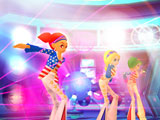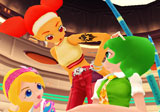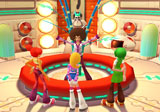 I have to admit that when
I was younger my most secret wish was to be a Solid Gold dancer. When Flashdance came out,
I bought legwarmers. And my secret affliction didn’t seem to get any better as I got
older. In fact it probably got worse, as it spread to other parts of my life. I even went
so far as to rent the Spice Girls video game to see what kind of dancer and choreographer
I could become. So I have to say, I probably have one of the most open adult minds about
dance-focused video games, even if I may not always be the intended target audience. I was
hoping that Unison: Rebels of Rhythm & Dance might be a game through which I could
live out my dreams, or at least have a few hours of fun. I left the game without getting
my groove thang shook even once.
I have to admit that when
I was younger my most secret wish was to be a Solid Gold dancer. When Flashdance came out,
I bought legwarmers. And my secret affliction didn’t seem to get any better as I got
older. In fact it probably got worse, as it spread to other parts of my life. I even went
so far as to rent the Spice Girls video game to see what kind of dancer and choreographer
I could become. So I have to say, I probably have one of the most open adult minds about
dance-focused video games, even if I may not always be the intended target audience. I was
hoping that Unison: Rebels of Rhythm & Dance might be a game through which I could
live out my dreams, or at least have a few hours of fun. I left the game without getting
my groove thang shook even once.
While a younger audience might be a little more forgiving than I am about plot and its
execution, I keep hoping that video game writers will get the idea that their fan base (no
matter how young) is a lot more savvy than they are giving them credit for, and that a
stronger story might broaden their age demographic. In Unison, three young girls (Trill,
Cela, and Chilly) are recruited by Doctor Dance to help him bring dancing back to Twin
Ships and wrest control back from the evil anti-dancer, Ducker. The Doctor will interrupt
Ducker’s transmissions to broadcast his three "peaches" dancing to hits
from our century (they’re living 200 years in the future). Now that setup isn’t
so bad to begin with, but the way it is carried out is pretty unimaginative and the
dialogue is terrible, even if we try to defend it as "just a cheesy dance game."
The game strives to be a three-way cross between the seventies disco fever, the eighties
valley girl phenomena ("like, ya know?") and hip nineties rap fest, and yet
still try to be reflective of the future. However, besides Chilly’s pet robot,
there’s not too much of the future going on here.
 The game has a main story mode and a side distraction called Club Tecmo. In the
main game, you can choose which girl you will focus on (Trill is the "easy"
setting, Cela the "hard," and Chilly the "very hard"). You are given a
short dance number which you can practice and break down into portions which are easier to
learn. The object is to copy the moves the computer makes with your analog sticks and when
you’re ready, you can perform for the doctor and then get broadcast out into Twin
Ships. You receive a grade, and as long as you get higher than a "D" you can
continue playing. In Club Tecmo, you can re-perform dance numbers you learned before and
can earn new songs. This second option would be a lot more fun if it were not for one
fairly serious problem.
The game has a main story mode and a side distraction called Club Tecmo. In the
main game, you can choose which girl you will focus on (Trill is the "easy"
setting, Cela the "hard," and Chilly the "very hard"). You are given a
short dance number which you can practice and break down into portions which are easier to
learn. The object is to copy the moves the computer makes with your analog sticks and when
you’re ready, you can perform for the doctor and then get broadcast out into Twin
Ships. You receive a grade, and as long as you get higher than a "D" you can
continue playing. In Club Tecmo, you can re-perform dance numbers you learned before and
can earn new songs. This second option would be a lot more fun if it were not for one
fairly serious problem.
The moves that you do merely represent which side of the body the computer is moving
and have very little real correlation to the actual moves the dancers make. There are no
combinations to remember, which might be nice for the much younger members of the target
audience, but it pretty much ruins the idea of creativity or true skill on the part of the
players. What it becomes is a test to see if you remember which analog move comes next and
manipulating your controller to follow your directions correctly. So as a memory game,
this title has a lot of potential. But as a dance game, the lack of true unique options
for movement is a real downer. This makes Club Tecmo only a place to re-do old dance moves
and not really a place to create, even when they give you new music for progressing
further in the story mode.
 A place where I thought they really could have broadened the game’s target
audience and skill level is with the different dancers, so I was pretty excited when I saw
that the girls represented different challenges. But what ends up happening is that the
songs and plot exposition are the same and the moves are the same sort of controlled
movement. The only real difference is that the computer requires more segments where you
have to complete a movement on every eighth-note and you’re required to use diagonals
on the analog stick. So while the girls represent different skill levels, the moves really
aren’t that different and it only requires slightly more dexterity and memorization
to play "very hard" than it does to play "easy."
A place where I thought they really could have broadened the game’s target
audience and skill level is with the different dancers, so I was pretty excited when I saw
that the girls represented different challenges. But what ends up happening is that the
songs and plot exposition are the same and the moves are the same sort of controlled
movement. The only real difference is that the computer requires more segments where you
have to complete a movement on every eighth-note and you’re required to use diagonals
on the analog stick. So while the girls represent different skill levels, the moves really
aren’t that different and it only requires slightly more dexterity and memorization
to play "very hard" than it does to play "easy."
As far as graphics go, this game is set up to be cartoon cute Japanimation, so I
didn’t expect too much detail. However, the game had a lot of fry in the backgrounds
and the sideline characters weren’t very detailed at all. The main characters had
more time and detail put into them, and were much more fun to watch. I especially
appreciated the nearly gelatinous mega-afro of Doctor Dance that looked like it could
boogie on its own. Probably the highlights were the "stage" backgrounds that
Doctor Dance programmed for the broadcast shows, which are a little more interesting, but
in general, the graphics aren’t anything to write home about.
The music that was original worked very well in the game, but I was almost offended
that they used remakes of such hits as "YMCA" and "We are Family." And
one of the rap songs they used had barely edited references to smoking dubious substances
that may not have been appropriate for the demographic they seemed to be targeting.
However, the re-makes grew on me, and the music ended up being the strongest part of the
game.
This game might be a good rental for a younger demographic that’s not old enough
to rise to the occasion of a more difficult level of gaming. Some of the humor might also
be more appreciated. But as soon as your video gamer gets to the point where they
understand that their movements with the controller have little to do with the dancers
movements and that they can’t really create more complex and cool moves, the game
will lose its appeal fairly quickly. I have to say that I’m looking forward to the
day when the dance game catches up with the type of complexity and intuitive level of
movement as such games as Tekken. It’s really the same sort of idea in a different
arena, and I know kids as young as six and as old as…well, lets just say older
adults, who can play and love the game. Granted, the gamer must have a need to dance, but
I think that games can be made that cater to all types and skill levels of the wanna-be
groover. Rent Unison if you must, but cross your fingers with me that something better is
coming along shortly.
